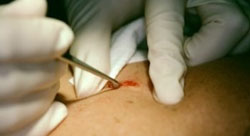Moles are increasingly becoming a condition that dermatologists have to work through lately. They are most often observed in the early years of adult life, between thirty to forty years of age. They may become a problem, particularly depending on their location on the body. Moles can be dangerous to a person’s health as they may contain melanoma cancerous cells, not mentioning the self-confidence problems that they spawn among people. It is paramount to handle moles at the earliest possible convenience. One of the safest possible methods is to employ cosmetic mole removal surgery.

Is Surgery Worth It
To decide whether cosmetic mole removal surgery should be performed for your case, consult with a doctor first. Mole removal surgery is an approach that quickly removes the mole and the surrounding skin area heals fast. This procedure is not recommended for small, benign moles.
The following factors should be considered for mole removals:
- The physical location of the mole
- Is the mole benign or malignant
Typically surgery is ideal for moles that have recently changed in color, shape or size. - What are the costs associated
Your budget should be a critical factor to consider - surgery can be expensive It’s wise to check with your insurance to see if they cover any cosmetic procedures. - Is your mole itchy when it is exposed
Cosmetic mole removal is sometimes covered by insurance as the removal of a mole can stop the spread of potentially cancerous cells. The removal also leads to smoother, clearer and less irritated skin. As not all moles are cancerous, doctors will usually examine them carefully by running a biopsy. In this procedure, a small piece of the mole is cut using a either a scalpel or a biopsy tool that cuts just a sliver of the mole off for analysis. This sample is sent to a pathology lab for examination.
Solutions, Albeit Temporary
If the lab examination reveals the mole as non-cancerous, the doctor cuts the protruding part of the mole so it’s level with the skin. This is the procedure used for most benign moles. Shaving off the protruding part of the mole does not remove the mole cells beneath the skin and these cells usually grow back in several months to years. If the mole isn’t cancerous though, there’s no reason to attempt invasive surgery.
The quick “snip” of a skin flap will occur for both benign or cancerous mole cells. This procedure is referred to as elliptical excision. A small medical blade is used in cosmetic mole removal or a laser. A bandage is applied on top of the area that was operated. This procedure usually takes about an hour. The wound area is expected to heal in within a week and you can return to your normal schedule within a week. For cancerous mole treatment, usually surgery will take longer and encompass the removal of a chunk of skin around where the mole was to ensure all cancerous cells are gone.
